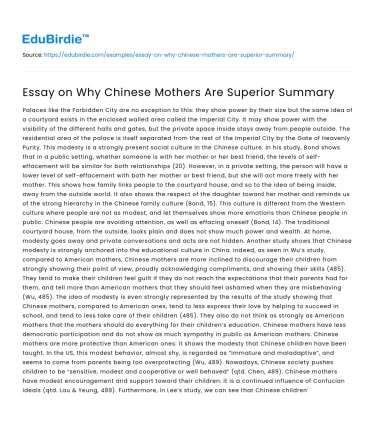Palaces like the Forbidden City are no exception to this: they show power by their size but the same idea of a courtyard exists in the enclosed walled area called the Imperial City. It may show power with the visibility of the different halls and gates, but the private space inside stays away from people outside. The residential area of the palace is itself separated from the rest of the Imperial City by the Gate of Heavenly Purity. This modesty is a strongly present social culture in the Chinese culture. In his study, Bond shows that in a public setting, whether someone is with her mother or her best friend, the levels of self-effacement will be similar for both relationships (20). However, in a private setting, the person will have a lower level of self-effacement with both her mother or best friend, but she will act more freely with her mother. This shows how family links people to the courtyard house, and so to the idea of being inside, away from the outside world. It also shows the respect of the daughter toward her mother and reminds us of the strong hierarchy in the Chinese family culture (Bond, 15). This culture is different from the Western culture where people are not as modest, and let themselves show more emotions than Chinese people in public. Chinese people are avoiding attention, as well as effacing oneself (Bond, 14). The traditional courtyard house, from the outside, looks plain and does not show much power and wealth. At home, modesty goes away and private conversations and acts are not hidden. Another study shows that Chinese modesty is strongly anchored into the educational culture in China. Indeed, as seen in Wu’s study, compared to American mothers, Chinese mothers are more inclined to discourage their children from strongly showing their point of view, proudly acknowledging compliments, and showing their skills (485). They tend to make their children feel guilt if they do not reach the expectations that their parents had for them, and tell more than American mothers that they should feel ashamed when they are misbehaving (Wu, 485). The idea of modesty is even strongly represented by the results of the study showing that Chinese mothers, compared to American ones, tend to less express their love by helping to succeed in school, and tend to less take care of their children (485). They also do not think as strongly as American mothers that the mothers should do everything for their children’s education. Chinese mothers have less democratic participation and do not show as much sympathy in public as American mothers. Chinese mothers are more protective than American ones: it shows the modesty that Chinese children have been taught. In the US, this modest behavior, almost shy, is regarded as “immature and maladaptive”, and seems to come from parents being too overprotecting (Wu, 489). Nowadays, Chinese society pushes children to be “sensitive, modest and cooperative or well behaved” (qtd. Chen, 489). Chinese mothers have modest encouragement and support toward their children: it is a continued influence of Confucian ideals (qtd. Lau & Yeung, 489). Furthermore, in Lee’s study, we can see that Chinese children’s education has an emphasis on self-effacement and modesty. Indeed, in the study, the children rated negatively a child saying to his teacher that he has done something good, because they considered that the child was “begging for the teacher’s praise” (Lee, 930). This behavior is highly discouraged by Chinese teachers (qtd. Zhu, 930). A third of the Chinese children in this study said that they “should not leave their name if they have done a good deed” (Lee, 930).
To conclude, the traditional courtyard Chinese house comes from the idea of protection from the outside world. It protects the entire family which is the most important social category in China. The strong hierarchical idea within the family in China has been anchored in the culture for many centuries and is still strong as of now. Chinese people do not let themselves show their weaknesses outside of the courtyard house, they act modestly in public, with modesty that they have been taught since they were children.
Save your time!
We can take care of your essay
- Proper editing and formatting
- Free revision, title page, and bibliography
- Flexible prices and money-back guarantee
Works Cited
- Bond, Michael H., et al. “Enacting modesty in Chinese culture: The joint contribution of personal characteristics and contextual features”, Asian Journal of Social Psychology, Vol 15, 2012, pp.14-25.
- Hu, Xiao. “Boundaries and openings: spatial strategies in the Chinese dwelling”, Journal of Housing and the Built Environment, Vol 23 Issue 4, Dec 2008, pp.353-367.
- Kostof, Spiro. A History of Architecture: Settings and Rituals. Original Drawings by Richard Tobias. Oxford University Press, 1985, pp.231-233.
- Lee, Kang, et al. “Chinese and Canadian Children’s Evaluation of Lying and Truth Telling: Similarities and Differences in the Context of Pro and Antisocial Behaviors”, Child Development, Vol. 68, No. 5, Oct. 1997, pp.924-934.
- Wu, Peixia, et al. “Similarities and Differences in Mothers’ Parenting of Preschoolers in China and the United States.”, International Journal of Behavioral Development, Vol. 26, No. 6, 2002, pp.481-491






 Stuck on your essay?
Stuck on your essay?

